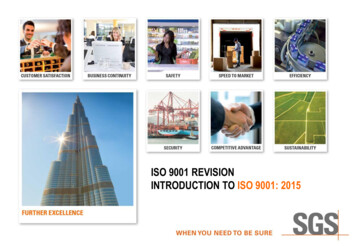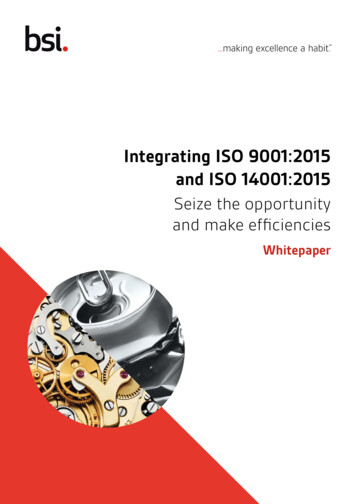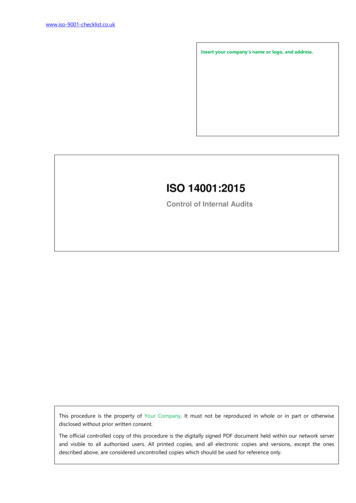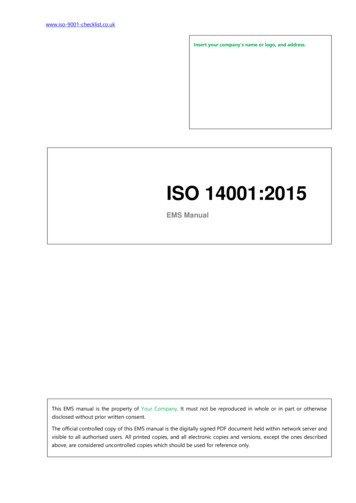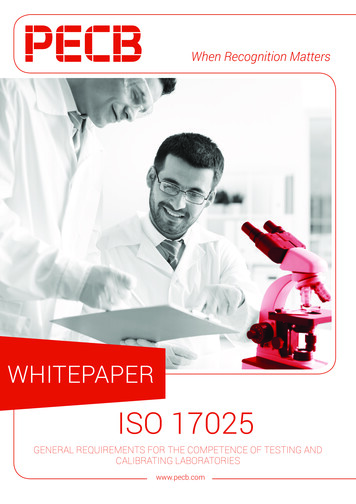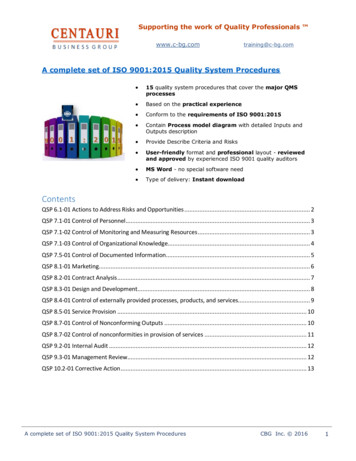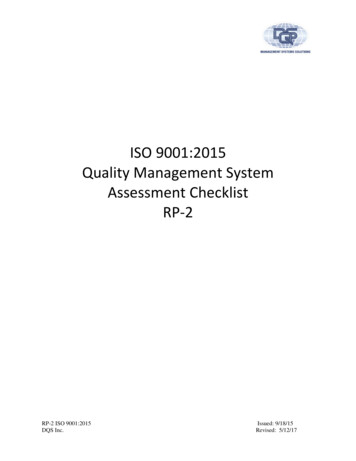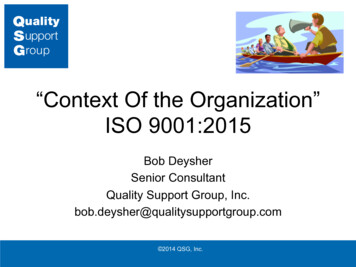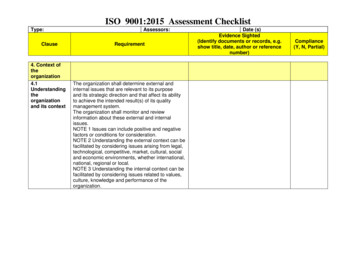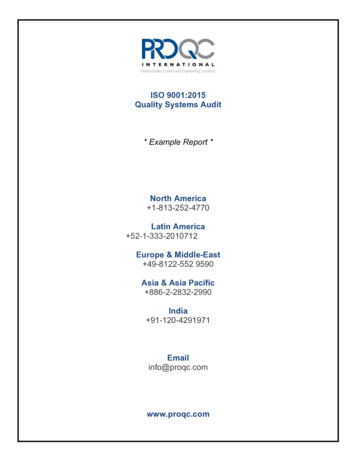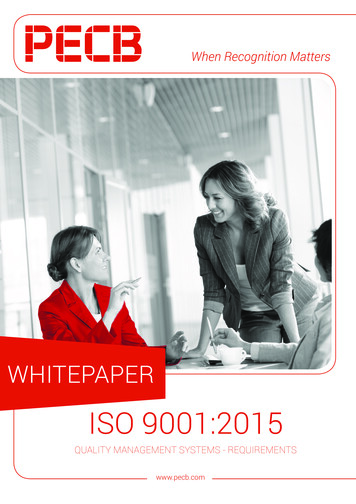
Transcription
When Recognition MattersWHITEPAPERISO 9001:2015QUALITY MANAGEMENT SYSTEMS - REQUIREMENTSwww.pecb.com
CONTENT3Introduction4An overview of ISO 9001:20154Key clauses of ISO 9001:20159Integration with other management systems9Quality Management – The Business Benefits11Implementation of a QMS with IMS2 methodology12Certification of organizations13Training and certifications of professionalsPRINCIPAL AUTHORSERIC LACHAPELLE, PECBFATON ALIU, PECBLORIKA BINA, PECBCONTRIBUTORSALKESH MISHRA, MOULIK IT SERVICES LLPANDERS CARLSTEDT, CARLSTEDT INC.MICHAEL GRAY, PIRII AUSTRALIA PTY. LTD.PIERRE DEWEZ, ALTIRIANRENÉ ST GERMAIN, ALTIRIAN2ISO 9001:2015 // QUALITY MANAGEMENT SYSTEMS - REQUIREMENTS
INTRODUCTIONQuality management is the act of managing all activities and functions needed to maintain a consistentlevel of excellence in an organization, product or service. Quality is an essential factor that differentiates anorganization from its competitors. Undertaking quality initiatives will lead to superior products or serviceswhich meet and exceed customer expectations, increase revenues and productivity for the organization.Quality has become a global priority as many organizations have benefited from its practices. Commitmentto quality is related to the intent to remain competitive and stay in business due to increased globalcompetition. Quality management is crucial for the successof every organization, which is why many organizationsThe Cost of Qualityengage in the process of continual improvement to secureThecostof quality measures thetheir future. Paying attention to quality management haslackofquality,or the result of notproven to lead to successful and competitive organizations,improving the quality performancewhich are capable of offering superior products and services.beforehand. Improving quality ishighlyimportant for organizationsDue to the above mentioned facts many organizations arethatwantto achieve their objectives.setting programs in place for managing quality. There areTaking measures before the productsdifferent systems, methodologies, tools and techniquesor services are produced or offeredthat help in improving the quality performance. They canlowersthe risk of having a high costbe used separately or simultaneously towards achievingof quality.the established goals for quality management, and desiredlevel of quality. Usually these programs cover the majorityof activities aiming to optimize operations. The reason why organizations undertake quality initiatives isbecause poor quality management can have a negative effect on organizations, and may even lead tobusiness failure. Businesses should strive to improve their performance by employing the techniquesthat lead to improved organizational effectiveness and efficiency, employee loyalty, increased customersatisfaction and market share, higher productivity, improved profitability and organizational culture.The International Organization for Standardization (ISO) published standards on quality management whichare accepted and widely used worldwide. One of the most commonly used ISO standards is ISO 9001, whichis a Quality Management System Standard that addresses various quality management issues. The ISO9000 family of standards provides guidance and the necessary quality management tools for organizationswho want to ensure that their products and services meet customer’s requirements.ISO 9001:2015 // QUALITY MANAGEMENT SYSTEMS - REQUIREMENTS3
An overview of ISO 9001:2015The International Organization for Standardization (ISO) is a non-governmental organization whose roleis to facilitate international coordination and the standardization of industrial standards. These standardscontribute to the development, manufacturing and delivery of products and services that are more effective,safer and clearer. ISO performs systematic reviews every 3-5 years to keep these standards up-to-date.The revision process adjusts them to changes in theenvironment with the aim at improving organization’sability to offer products and services that meetWhat is Quality Management Systemcustomer’s requirements. ISO has revised world’s leading(QMS)?Quality Management System (QMS), ISO 9001:2008 toISO 9001:2015.Quality management system is definedas a set of interrelated or interacting eleISO 9001:2015 specifies requirements to plan, establish,ments to establish policies, objectives,implement, operate, monitor, review, maintain andand processes to achieve those objeccontinually improve a documented management systemtives with regard to quality.used to manage quality. The requirements set in ISO9001:2015 are generic, flexible and useful to all typesQMS is part of the overall managementof organizations. Thus, this ISO Management Systemsystem, based on a business risk apStandard can be aligned and integrated with otherproach, to establish, implement, operate,Management Systems such as Energy Management,monitor, review, maintain and improveBusiness Continuity Management and other managementquality.systems, due to their similar structure.Quality management standardization evolves with ISO 9001:2015 by adding: Greater emphasis on process approach, risk management, monitoring performance and metrics;Better focus on interested parties;More careful analysis of the context of the organization needed for ensuring quality improvement;ISO 9001 applies to all types and sizes of organizations that wish to:1.2.3.4.5.establish, implement, maintain and improve a QMS;assure conformity with the organization’s stated quality policy;demonstrate conformity to others;seek certification/registration of its QMS by an accredited third party certification body; ormake a self-determination and self-declaration of conformity with this International Standard.ISO 9001:2015 is the first quality management standard to be fully compliant with the new guidelines fromAnnex SL (“High level structure and identical text for management system standards and common coremanagement system terms and definitions”). It has been developed in response to standards users’ criticsthat, while current standards have many common components, they are not sufficiently aligned, making itdifficult for organizations to rationalize their systems and to interface and integrate them. This means thatISO 9001 is integrated to the high-level structure and common text that will make it totally aligned with allother management systems once the related standards have also adopted the Annex SL guidelines.Key clauses of ISO 9001:2015Following the new structure of the Annex SL, ISO 9001 is organized into the following main clauses:Clause 1: ScopeClause 2: Normative referencesClause 3: Terms and definitionsClause 4: Context of the organizationClause 5: LeadershipClause 6: Planning for the quality management system4ISO 9001:2015 // QUALITY MANAGEMENT SYSTEMS - REQUIREMENTS
Clause 7: SupportClause 8: OperationClause 9: Performance evaluationClause 10: ImprovementEach of these key areas is listed and described below. CLAUSE 4: CONTEXT OF THE ORGANIZATIONThe organization shall determine external and internal issues that are relevant to its purpose and its strategic direction and that affect its ability to achieve the intended result(s) of its QMS such as: issues arising from technological, competitive, market, culture, social, and economic environments;issues related to values, culture, knowledge and performance of the organization;the identified needs and expectations of relevant interested parties;applicable legal, regulatory and other requirements to which the organization subscribes.Defining the scope of the QMS, taking into account the organization’s strategic objectives, key products and services, risk tolerance, and any regulatory, contractual or stakeholder obligations is also part of this alityObjectivesObjectivesCorporate PolicyQuality Policy CLAUSE 5: LEADERSHIPTop management shall demonstrate leadership and commitment with respect to the quality managementsystem by: Taking accountability of the effectiveness of the quality management system;Ensuring that the quality policy and quality objectives are compatible with the strategic direction andthe context of the organization;Ensuring that the quality policy is communicated, understood and applied within the organization;Ensuring the integration of the QMS requirements into the organization’s business processes;Promoting awareness of the process approach;Ensuring that the resources needed for the QMS are available;Ensuring that the QMS achieves its intended results;Engaging, directing, and supporting persons to contribute to the effectiveness of the QMS;Promoting continual improvement;ISO 9001:2015 // QUALITY MANAGEMENT SYSTEMS - REQUIREMENTS5
Ensuring that customer requirement and applicable statutory and regulatory requirements are determined and met;Ensuring that the risks and opportunities that can affect conformity of products and services and theability to enhance customer satisfaction are determined and addresses;Establishing, reviewing and maintaining the quality policy;Ensuring that the responsibilities and authorities for relevant roles are assigned, communicated andunderstood within the organization. CLAUSE 6: PLANNING FOR THE QUALITY MANAGEMENT SYSTEMThis is a critical stage as it relates to establishing strategic objectives and guiding principles for the QMS asa whole. The intent of the organization to treat the risks identified and/or to comply with the QMS requirements can be expressed through the QMS objectives. The quality objectives shall: be consistent with the quality policy;be measurable;take into account applicable requirements;be relevant to conformity of products and services and the enhancement of customer satisfaction;be monitored, communicated and updated as appropriate.An organization wishing to comply with ISO 9001 shall at least: Select and define a risk assessment methodology.Demonstrate that the selected methodology will provide comparable and reproducible resultsDefine criteria for accepting risks and identify acceptable levels of risk. CLAUSE 7: SUPPORTThe day-to-day management of an effective qualitymanagement system relies heavily on using the appropriate resources for each task. These include having competent staff with relevant (and demonstrable) training and supporting services, awareness andcommunication. This must be supported by properlymanaged documented llstexCoPtPerformanceernntiotiracntThe requirements on the creation, update and controlof documented information are also specified in thisclause.BehavioralskillsCoBoth internal and external communications of the organization must be considered in this area, includingthe format, the content and the proper timing of suchcommunications.Context CLAUSE 8: OPERATIONAfter planning the QMS, an organization must put it into operation. This clause includes: Operational planning and control: This activity includes implementation of plans and processes that leadthe organization towards meeting the quality management system requirements. Additionally, this clause requires from organizations that they establish controls which help in preventing any deviation from the qualitypolicy, objectives, and legal requirements.After the requirements have been established, the organization should control the planned changes and review the unintended changes to mitigate any adverse effect. All the processes within the organization, including outsourced processes should be controlled.6ISO 9001:2015 // QUALITY MANAGEMENT SYSTEMS - REQUIREMENTS
Determination of requirements for products and services: The organization shall determine all the requirements related to products and services, such as customer requirements, organizational, statutory and regulatory, and ISO 9001:2015 requirements. The organization shall establish an effective customer communicationprocess. After all the requirements have been determined, they must be reviewed to ensure contract or orderrequirements differing from those previously defined are resolved. Design and development of products and services: This activity requires that organizations establish, implement and maintain a design and development process. Control of externally provided products and services: The organization shall ensure that externally provided processes, procedures, and services conform to specified requirements. This clause applies to bothphysical products and consumed services related to the end product of the organization. An organization willneed to apply a risk-based approach and determine the type and extent of controls necessary. Production and service provision: Businesses should control delivery and post-delivery activities to ensurethat the product and service provision is implemented under controlled conditions. This requirement expectsfrom organizations to have traceability mechanism to identify process outputs, protect and safeguard theproperty belonging to customers or external providers, and to preserve the products and services. Release of products and services: Organization should verify conformance to acceptance criteria when releasing the products and services. Acceptance criteria is the criteria set by the organization specifying certainindicators or measures employed in assessing the ability of a component, structure, or system to perform itsintended function. Setting the criteria before initiating the project makes its development much easier. Eachorganization should define its own criteria in order to ensure a higher level of customer satisfaction. Control of nonconforming process outputs, products and services: This activity involves identification ofcontrol of products and services to ensure that they comply with the stated requirements. Nonconforming processes, products and services have to be corrected, segregated, or ret
ISO 9001:2015 specifiesrequirements to plan, establish, implement, operate, monitor, review, maintain and continually improve a documented management system used to manage quality. The requirements set in ISO 9001:2015 are generic, flexible and useful to all types of organizations. Thus, this ISO Management System Standard can be aligned and integrated with other Management Systems
